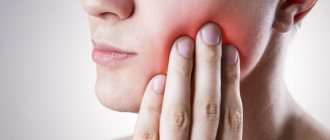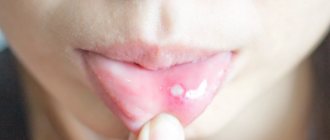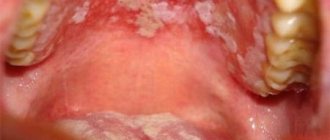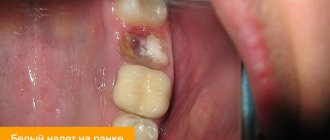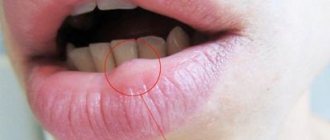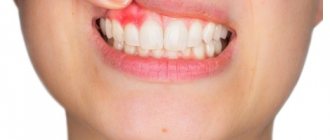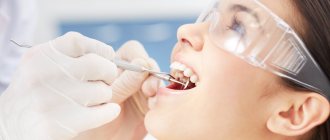This article describes all the possible causes of the appearance of bubbles in the mouth on the mucous membrane and effective methods of treating the resulting pathology.
The first sign that allows you to suspect the occurrence of a formation in the mouth is the sensation of a foreign object.
Depending on its location, the bubble will cause various symptoms:
- Pain when chewing food if the bubble is located on the gums or tongue.
- Pain when talking or smiling occurs when a bubble appears on the inner surface of the lips.
- Pain and the sensation of a fish bone stuck in the throat occurs if the bubble is located at the root of the tongue, in the oropharynx or in the upper part of the larynx.
If you look at the neoplasm, you can see and evaluate the nature of the changes in the tissue:
- An elevation above the level of the mucosa in the form of a tubercle.
- Redness around the raised area.
- Swelling of the tissue around the elevation.
The 3 above signs are often signs of an inflammatory process and require careful monitoring of the course of the disease in order to promptly and correctly prescribe treatment.
It is worth noting that the bubble can be not only inflammatory in nature. If the formation of a vesicle and its presence are not accompanied by pain, redness, or swelling of the mucosal tissue, then the cause of the vesicle is not an inflammatory process, which narrows the range of possible causes and radically changes the direction of treatment.
In this case, you need to contact a dermatologist who will assess your health. In this case, treating yourself is dangerous to your health.
Bumps in the mouth: what they are, their causes and treatment
Any neoplasms in the oral cavity require careful study of the clinical picture. This can be either a harmless growth or an alarming signal from the body. Thus, a lump on the roof of the mouth often occurs as a result of a cold or infection. This formation does not cause discomfort and resolves on its own after strengthening the immune system. If the growth is accompanied by pain and other unpleasant symptoms, this may indicate a serious pathology. Only a doctor can determine the cause of the lump and tell you what to do.
Causes
The most common reason why blood blisters appear in the mouth is an accidental injury to the mucous membrane. There are three possible damage options:
Mechanical
A blood blister is formed when accidentally biting while talking or eating. The mucous membrane can also be injured:
- hard foods: candies, crackers, bones;
- broken, chipped teeth or incorrectly made dental structures: braces, bridges, crowns, dentures;
- during hygiene procedures - tissues are damaged due to careless movements while brushing teeth with a brush or toothpick.
In addition, you can bite your cheek during an epileptic seizure, during sleep, or during severe excitement. In these cases, the patient may not remember the moment the injury occurred.
A blister may appear after biting with your teeth.
Important! Less commonly, a bloody blister can form due to dental surgery. It is associated with careless actions of the doctor during sanitation of the oral cavity.
Thermal
A blister on the cheek can form when the mucous membrane is burned by hot drinks, dishes, when inhaling steam or accidentally touching heated cutlery. In this case, the appearance of a bubble is accompanied by a burning sensation, swelling, redness and slight pain.
Chemical
The cause is tissue damage by aggressive chemical elements: accidental ingestion or inhalation of vapors at home or at work may cause bubbles to appear. As with thermal injury, mucosal hyperemia and painful sensations are observed.
Important! Provoking factors for the appearance of blisters in the oral cavity include smoking, abuse of strong alcohol, and hypovitaminosis. It is believed that under the influence of harmful elements and a lack of vitamins, the walls of blood vessels become thinner. This provokes hemorrhage and the formation of hematomas.
Traumatic causes are typical for single bloody or serous formations. If bubbles appear regularly, there are many of them, they are localized not only on the cheek, but also on the tongue, gums, lips, and are accompanied by other symptoms (plaque, itching, unpleasant odor) - this indicates diseases of the oral cavity or systemic pathologies. Among these factors are:
- stomatitis;
- syphilis in the mouth;
- tuberculosis;
- disruption of the gastrointestinal tract;
- diseases of the endocrine system;
- hemangioma;
- vascular tumor;
- pemphigus.
Provoking factors for the appearance of blisters in the oral cavity include smoking, abuse of strong alcohol, and hypovitaminosis.
Why do bumps appear in the sky?
A growth in the mouth appears as a result of blockage of blood vessels and stagnation of organic fluids, which causes inflammation in the mucosal tissues. Among the most common causes of pathology are the following:
- bad habits – alcohol abuse and smoking;
- chronic diseases – sore throat, sinusitis;
- constant exposure to traumatic factors - incorrectly fitted crowns that become infected, eating too hot food, sucking on lollipops, etc.;
- insufficient oral hygiene - food remains behind the teeth become a favorable environment for the development of pathogenic microflora;
- inflammation of the salivary glands;
- colds and infectious diseases;
- Doctor’s mistakes – incorrect filling or tooth extraction.
A child can also develop a lump in the mouth. In most cases, the pathology occurs due to bruises, which are quite common in childhood.
Bumps also form in the mouth due to cancer (leukoplakia and papillomatosis), which pose a great danger to human health and life.
Why did herpes appear on the gums?
For the virus to make itself felt, two things are enough: its presence in the blood and a weakened immune system.
Infection occurs by airborne droplets and can be transmitted from mother to child. Unfortunately, once you become infected with herpes, you can no longer get rid of it. But you can prevent its activation.
So, after infection, virus particles settle in the body forever. Most of the time the virus does not manifest itself in any way. What factors provoke the manifestation of the virus on the gums? Stress, including sudden nervous shock, chronic depression and fatigue, colds, bacterial and viral diseases, hypothermia, autumn or spring hypovitaminosis. A common cause of the appearance of “bubbles” characteristic of this disease is acclimatization. Are you familiar with the situation when the disease manifests itself on vacation, when changing time zones? Therefore, when planning trips, it is better to immediately stock up on antiviral drugs and ointments.
General symptoms
A tumor formed in the oral cavity can be of different colors: white, dark red, blue, transparent yellow. Sometimes it is soft, in other cases it is dense. A lump that appears against the background of one pathology may differ depending on the individual characteristics of the patient’s body: age, general condition of his body, bad habits, etc.
The lump appears in the form of a bubble, growth, ball, compaction, tumor with faint edges. Spots (change in color of the mucous membrane) may also form in the affected area. In some cases, numbness is felt in a certain part of the oral cavity, difficulties appear when swallowing, and the voice changes. In advanced forms of the disease, the cones may be damaged, which provokes bleeding with an unpleasant taste and odor.
Painful lumps indicate inflammation and suppuration. General health worsens, body temperature may rise. Purulent intoxication of the body occurs. In this case, the lump grows, it becomes hard and hot, and the regional lymph nodes enlarge.
The mechanism of formation of bubbles in the mouth
A blister on the inside of the cheek is a hematoma, or bruise. It is a small, from a few millimeters to a couple of centimeters, rounded formation. The internal exudate is serous or bloody, depending on the extent of the injury. In the first case, the blister is gray-white, in the second it is red, with a possible bluish tint.
Blood blisters appear due to injuries to the mucous membrane. Their formation is a natural reaction of the immune system to an irritant. It consists in:
- Activation of the body's defense mechanisms in response to an irritant. Agranulocytes arrive at the site of the lesion: leukocytes and monocytes. The latter, when leaving the blood into the tissues, are converted into macrophages. These cells capture the pathogen, neutralize it, and then die.
- The death of agranulocytes leads to their release to the site of injury. This process is a signal of injury to the body. After which it begins to release histamine, bradykinin and serotonin into the affected area. They sharply increase the permeability of blood vessels.
- A spasm occurs at the site of injury. The blood flow becomes difficult, after which the vessels relax and the blood accumulated during the narrowing enters the injured area. It moves quickly and under pressure. As a result, the upper layer of the epithelium peels off and a blister filled with bloody contents forms.
Blood blisters appear due to injuries to the mucous membrane.
Important! The red or white growth is not dangerous. It is virtually painless and heals within a week. The only discomfort is associated with inconvenience when chewing and talking.
Diagnosis of diseases accompanied by the formation of lumps in the mouth
Tumors have appeared in the mouth, and the question is, which doctor should I contact? This symptom is a prerequisite for visiting the dentist. To diagnose the disease, the doctor will first conduct a visual examination and palpation, and collect an anamnesis. A puncture is taken from the resulting lump and a bacteriological examination is carried out, which makes it possible to determine the cause of its occurrence.
Based on the results obtained, the doctor determines the need to use other diagnostic methods:
- general tests;
- X-ray;
- Ultrasound;
- biopsy.
If the cause of the formation of a lump on the upper palate is beyond the scope of the dentist’s competence, the patient is prescribed consultations with other specialists (pediatrician, therapist, gastroenterologist, endocrinologist, hepatologist). Only after making a diagnosis will the doctor determine how to treat the disease.
What to do if a bubble is detected?
- Determine the appearance of the formation.
- Guess the time of its occurrence.
- Suggest the reason for its occurrence.
- Treat the oral cavity with local antiseptic preparations 4-5 times a day.
- After 12-16 hours, evaluate the effect of antiseptics, and if the result is positive, continue treatment. If the result is negative, seek medical help.
You should not neglect treatment in such a delicate problem, since a person is a social creature and his appearance can greatly influence his fate.
Dental diseases
At an advanced stage of periodontitis, a fistula forms near the tooth involved in the painful process. If periostitis (inflammation of the periosteum) develops, flux may appear. At first the lump is hard, but over time it becomes softer and filled with pus.
In case of periodontitis, the tooth is unfilled and the root canals are cleaned. After removing the exudate, oral baths are prescribed using special solutions. In case of periostitis, the dentist opens the tooth, places medications in the cavity, and closes it with a temporary filling. If this treatment does not help, the tooth is removed.
Treatment options
To treat blisters of the first group, broad-spectrum antibiotic therapy is used. The purpose of this treatment is to combat the cause of the disease, which is often microorganisms inside the human body.
For local treatment, it is better to use solutions of furatsilin, a weak solution of manganese.
They cause a disease, one of the symptoms of which is damage to the oral cavity. In such cases, in addition to local damage, there will be symptoms of general intoxication, enlarged lymph nodes, and sometimes a rash in other places on the skin.
A good addition to general treatment is the use of local anesthetic, disinfectant and antiseptic solutions for the oral cavity. They will quickly eliminate the symptoms of inflammation and pain, which will improve your well-being.
To treat group 2 blisters, it is better to use only topical medications. This will reduce possible side effects of general medications and ensure a quick recovery.
If it is not possible to purchase a solution of manganese and furatsilin, you can simply use soda-salt solutions, which do an excellent job against staphylococci and streptococci. It is these bacteria that often cause most inflammatory processes in the oral cavity.
For herpes infection, it is better to use combined antiviral treatment, which consists of ointments, tablets and vitamins.
Angioma
It is a benign formation, which in most cases is a congenital pathology in children. It consists of blood vessels and is dark red in color. Sometimes it looks like a small ball on a leg. Lymphangioma, formed from lymphatic vessels, most often appears on the soft palate. It looks like a small bump with a bubbly surface. First, the tumor grows inside, then a swelling appears that hurts.
The choice of treatment method depends on the type of vessels. The angioma is removed or reduced by sclerotherapy, alcohol injection, or radiation therapy. If there is a risk of severe swelling, the formation is excised with a scalpel. The ball-shaped angioma is removed using a galvanoacoustic loop.
Preventive measures
To reduce the risk of developing pathologies in the oral cavity, you should follow a number of recommendations:
- quit smoking and alcohol;
- normalize nutrition - do not eat hot, salty and spicy foods, introduce fermented milk and plant products into the diet;
- carefully and regularly observe oral hygiene;
- start treatment of any pathologies in a timely manner;
- Take vitamin complexes periodically (after consultation with your doctor).
If you experience the slightest discomfort in the palate, you should see a dentist. Paying attention to your health prevents the development of complications.
Symptoms of herpes on the oral mucosa
Symptoms of herpes are individual, have varying degrees of manifestation, and can occur in different parts of the oral cavity. For most cases, there are a number of signs that indicate the occurrence of herpes:
- Regular headache;
- Fever;
- A person gets tired quickly;
- Discomfort when eating and drinking;
- The appearance of water bubbles filled with transparent white or yellowish exudate, up to 3 mm in diameter;
- The appearance of ulcers at the site of burst blisters;
- Inflammation of the soft tissues of the oral cavity, redness, itching, burning, swelling of the lesion.
According to clinical studies, blisters in the mouth can form in different areas: on the palate, on the inside of the cheeks, on the tongue, on the gums, on the tonsils.

